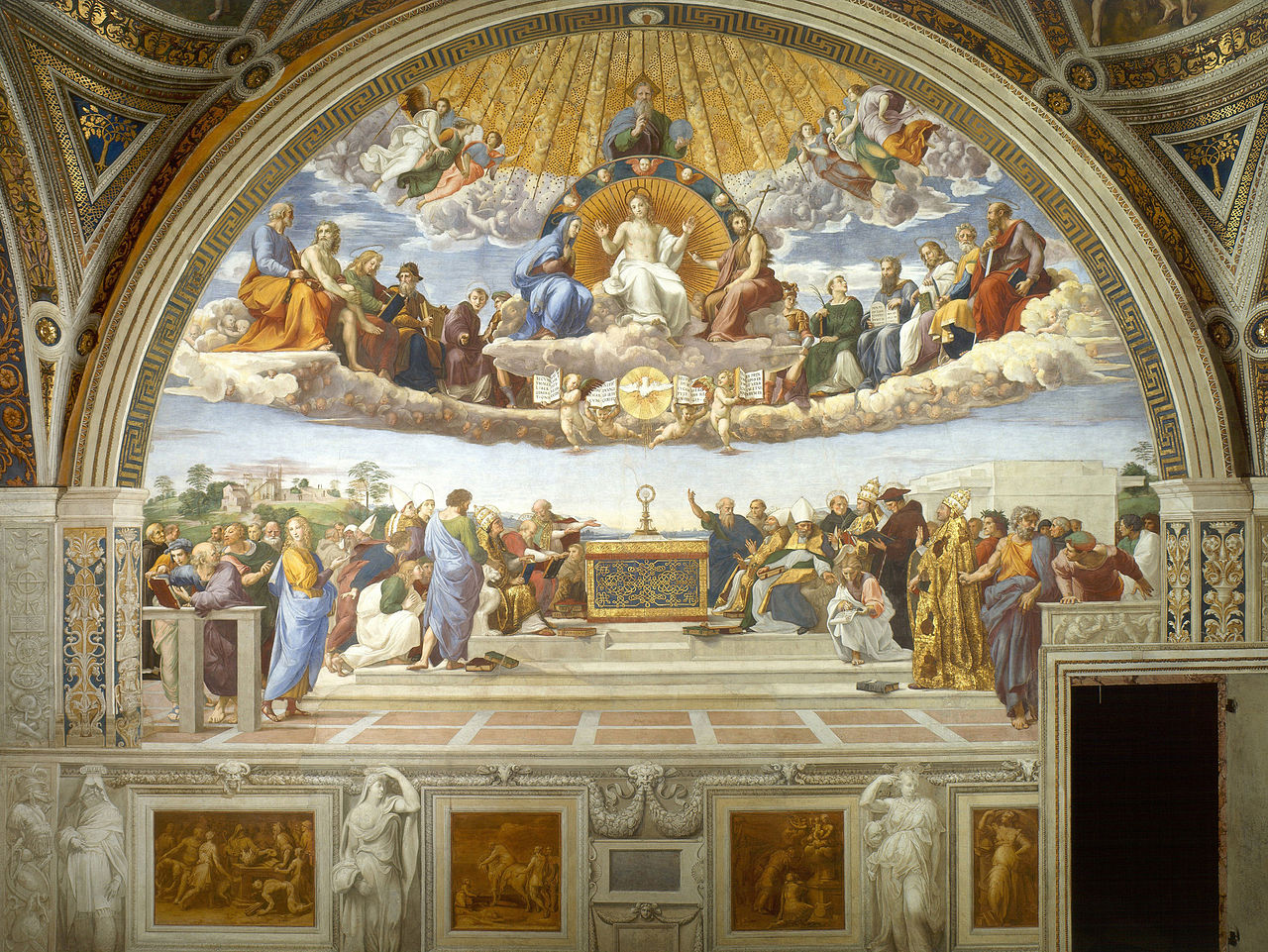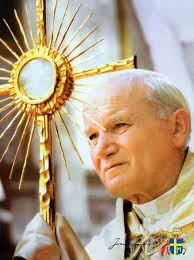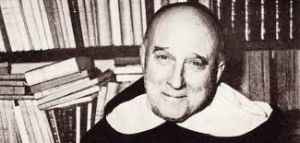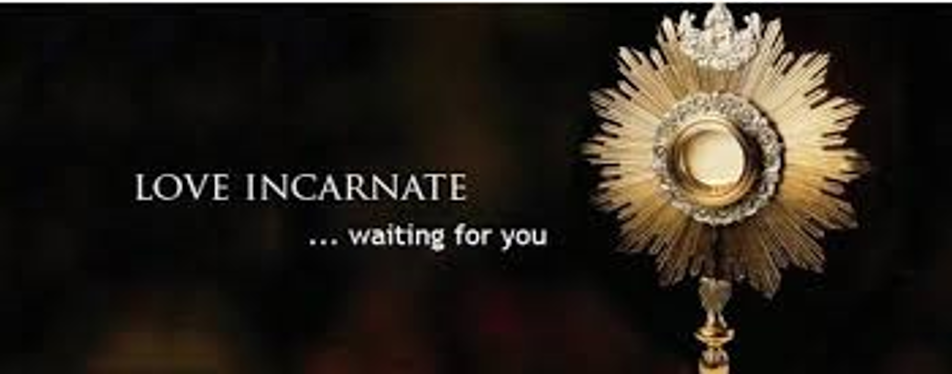PERPETUAL ADORATION

Disputation of the Sacrament by Raphael[i]
The defining charism of Association of Great Books Schools & Co-ops (“AGBSC”) is devotion to the Blessed Sacrament, which is also to say to Our Lord Jesus Christ.[ii] Where feasible, this will be manifest by perpetual adoration in a Blessed Sacrament chapel located on each school campus. Every Association of Great Books student and at least one of each student’s Catholic parents will commit to spend one hour each week before the Blessed Sacrament, on campus where this is possible.
In order to establish adoration of the Blessed Sacrament, each school will organize adoration according to local circumstances, in collaboration with their local diocese and parish. In general, to initiate and maintain perpetual adoration will necessitate a minimum student body approaching 80 students or so (to cover the 168 weekly hours). However, it is to be hoped that adoration will be initiated earlier, for limited periods.

Perpetual Adoration in Sacré-Cœur

Basilica of the Sacred Heart of Paris, commonly known as simply Sacré-Cœur.
In that regard, we are reminded of the building project of Sacré-Coeur Basilica on the Mount of Martyrs in Paris, as a
sanctuary of Eucharistic adoration, where day and night, for the 135 years since 1885, the Body of Christ in the Blessed Sacrament has been exposed and adored (except on Good Fridays), as an act of reparation to the Sacred Heart of Jesus for the violent, anti-Catholic outrages of the French Revolution – incipient in a time not unlike our own. Years before the dedication of the basilica, times of adoration were already organized in a provisory chapel. St. Thérèse of Lisieux was among the first contributors to the basilica, having donated her gold bracelet for the basilica’s monstrance.
“Outside the Eucharistic celebration, the Church is careful to venerate the Blessed Sacrament, which must be reserved as the spiritual center of the religious and parish community.”[iii] – St. Paul VI
Blessed Sacrament chapels, however small, will be the center of the life of each school or co-op associated with the Angelicum Academy. Students, parents, faculty and staff will endeavor to embellish the chapel with beautiful works of art, images and materials including, first of all, a beautiful monstrance.
The rationale for the founding of the AAASC is an effort to provide students, many of whom have lost access to their former schools, the most excellent education possible. This explains our dedication to the restoration of the study of the original texts of the classics – the Great Books – as the intellectual centerpiece for all four years of high school, as advocated by Dr. Mortimer Adler, renowned Catholic philosopher Jacques Maritain and many other educational reformers, which in turn explains why our high school students are able to earn so many college credits (up to 75), more than any other program in the US, thereby earning an accredited A.A. degree by 12th grade, and a B.A. just one year later. It also explains our incorporation of the classical Paideia in all grades. Finally, it explains why AAASC schools will have, as one of their hallmarks, perpetual adoration of the Blessed Sacrament.
We mentioned above the goal of providing students with the best education possible. What has that to do with perpetual adoration? Apart from the disastrous removal of the Great Books and the classical Socratic method from school and college curricula, we think an even greater loss is the removal of virtually any mention of contemplative prayer, which is the apex of education in the fullest sense, and the greatest contribution Catholic education can make to the life of students.
“Be still, and know that I am God.”[iv]
The Catechism defines contemplation as “a gaze of faith, fixed on Jesus. ‘I look at him and he looks at me’: this is what a certain peasant of Ars in the time of its holy Curé, St. John Vianney, used to say of praying before the tabernacle. His gaze purifies our heart; the light of the countenance of Jesus illumines the eyes of our heart and teaches us to see everything in the light of his truth and his compassion for all men. Contemplation also turns its gaze on the mysteries of the life of Christ. Thus it learns the ‘interior knowledge of our Lord’, the more to love him and follow him.”[v]
Similarly, St. Teresa of Avila defined contemplation as “nothing other than a close sharing between friends. It means frequently taking time to be alone with Him whom we know loves us.”[vi] “Contemplative prayer is “silent love.”[vii]
“Contemplation prolongs communion and enables one to meet Christ, true God and true man, in a lasting way, to let oneself be seen by Him and to experience His presence. When we contemplate Him present in the Blessed Sacrament, Christ draws near to us and becomes more intimate to us than we are to ourselves. He grants us a share in His divine life in a transforming union.”[viii] “thus uniting a person with the Second Person of the Blessed Trinity, bringing him into communion with intra-trinitarian life.”[ix] – Pope Benedict XVI[x]
Who is called to this intimacy with Christ – are all students, parents, faculty? The universal call to holiness is a teaching of the Catholic Church. “All the faithful of Christ of whatever rank or status are called to the fullness of the Christian life and to the perfection of charity.” [xi] Contemplation is necessary for the full perfection of Christian life. It belongs to the normal development of the Christian life of sanctity and is the chief characteristic of the mystical life, in which alone the true perfection of the love of God is to be found. It therefor follows that “All souls in a state of grace are in a general and remote manner called to the mystical life, as they are to that of heaven.”[xii]

St. John Paul II

Garrigou-Lagrange, O.P.
St. John Paul II wrote that holiness is not only a state but a task, whereby Christians should strive for a full Christian life, imitating Christ, God the Son, who gave his life for God the Father and for his neighbor. This entails a “training in the art of prayer“.[xiii] According to the sainted Pope, all pastoral initiatives –including perforce Catholic education – have to be set in relation to holiness, as this has to be the topmost priority of the Church. The universal call to holiness is explained as more fundamental than the vocational discernment to particular ways of life such as priesthood, marriage, or virginity. At the core of the spirituality of a Catholic is this call to perfection.
“I urge priests, religious and lay people to continue and redouble their efforts to teach the younger generation the meaning and value of Eucharistic adoration and devotion. How will young people be able to know the Lord if they are not introduced to the mystery of His presence?” [xiv]
“Give me an experience of God!” This plea of youth is sometimes said against what they perceive as a mere ethical code, or against allegiance to an institutional Church or “organized religion”. While ethical systems and the Church are vitally necessary, and objections to them are based on misunderstandings, nevertheless a desire to experience God – and not some substitute – is legitimate enough. In the Real Presence souls come to know and encounter Christ, experientially, by the secret, imperceptible infusion of love into the soul.[xv]
“Where have you hidden? Where can I find you?” So prayed St. John of the Cross. Only God, personally, could meet his need, and ours as well.[xvi] When St. John seeks an experience of God, he says what he intends by experience, he does not mean “feeling” as opposed to “not feeling”; he means “reality” as opposed to “mere theory”. He assured us of God’s willingness to communicate Himself, “at least in a hidden way.” [xvii] His search then, like our own, is not merely for a feeling of encounter, but for encounter, with Christ. He wants not just perfection, a theoretical state, but nothing less than “union”.
“It is invaluable to converse with Christ, and leaning against Jesus’ breast like His beloved disciple, we can feel the infinite love of His heart. We learn to know more deeply the One who gave Himself totally, in the different mysteries of His divine and human life, so that we may become disciples and in turn enter into this great act of giving, for the glory of God and the salvation of the world.” [xviii] “In one day the Eucharist will enable you to do more for the glory of God than a whole lifetime without it.”[xix]-St. Peter Julian Eymard

Venerable Fulton J. Sheen
“Neither theological knowledge nor social action alone is enough to keep us in love with Christ unless both are preceded by a personal encounter with Him. Theological insights are gained not from between two covers of a book, but from two bent knees before an altar. The Holy Hour becomes like an oxygen tank to revive the breath of the Holy Spirit in the midst of the foul and fetid atmosphere of the world.” –Venerable Fulton J. Sheen
We cannot “produce” contemplation, our faculties are incapable of acquiring it; but we can dispose ourselves for it,[xx] and this generally takes time. The Catechism of the Church states that: “One does not undertake contemplative prayer only when one has the time: one makes time for the Lord, with the firm determination not to give up, no matter what trials and dryness one may encounter.” [xxi] Hence the student/parent/faculty commitment in Angelicum schools to adoration.
Why include parents? As we all know, influenced by an increasingly irreligious and anti-Catholic culture, Catholic education at all levels has suffered a steady erosion of Catholic identity and purpose in many – indeed most – Catholic schools, colleges and universities, many even tolerating faculty teaching in direct contradiction of Catholic doctrine and the natural law, some even promoting the teaching of immoral notions with regard to vital issues such as abortion, the definition of marriage, gender identity and sexual behaviors.
Young students need the support of their parents to understand, reinforce and confirm what they will learn in interior whispers[xxii] from Our Lord before the Blessed Sacrament. Like Odysseus, we are all in the western sea between Aeaea and the rocks of Scylla, where the two modern Sirens (relativism and hedonism) especially entice the young to their destruction with their irresistibly beautiful singing. If we wish them to escape, just as Odysseus had his sailors lash him to the wood of the mast and fill their ears with beeswax, we must lash ourselves to the wood of the Cross by commitment, and fill our students’ ears with truth heard interiorly in that “still, small voice”[xxiii] of love in adoration before the Blessed Sacrament.

Ulysses and the Sirens – by John William Waterhouse
This is clearly not the time – if there were ever an appropriate time – to found lukewarm or mediocre Catholic schools with only superficial elements of Catholic identity. As one noted Catholic theologian put it: “ The Christian of the future will be a mystic or he will not exist at all.[xxiv] Indeed, at the Angelicum Academy we have no interest in any half-hearted endeavor, however probable “success” in secular terms may be due to the closure of so many Catholic, private and public schools. Better to found a few Catholic schools enflamed by perpetual contact with Our Lord in the Blessed Sacrament, than many floundering without it.
“Do you want many graces? Go and visit the Blessed Sacrament often. Do you want few graces? Visit the Blessed Sacrament rarely. Do you want none at all? Then never pay a visit to the Blessed Sacrament.” – St. John Bosco
We think now is the time to return to the source, the center of Christian life,[xxv] and evangelization,[xxvi] and the summit of the Church’s spiritual and charitable activity,[xxvii] “for in the Eucharist is contained the whole spiritual good of the Church, namely Christ Himself,”[xxviii] still present with us, as He promised.[xxix]
Appropriate arrangements being made with local diocesan or religious priests, besides the said weekly adoration, each Angelicum Academy will have daily Holy Mass, for all students, and weekly Benediction of the Blessed Sacrament. July 12, 2020
We invite readers to view the Veil Removed – a short film that reveals the coming together of heaven and earth at Mass, as seen by saints and mystics, revealed by scripture and in the catechism of the Catholic Church.
[i] In his 1509-10 fresco the Disputation of the Sacrament, Raphael created a scene spanning both heaven and earth. Above, Christ is surrounded by an aureole, flanked by the Blessed Virgin Mary and St. John the Baptist to his right and left (an arrangement known as the Deësis). On an altar sits the monstrance. The altar is flanked by theologians who are depicted discussing Transubstantiation. Christ’s Body, Blood, Soul, and Divinity is the Holy Eucharist, among them are the original four great Doctors of the Church (identified by their names inscribed into their halos), with Pope GregoryI and Jerome seated to the left of the altar and Sts. Augustine and Ambrose to the right.
[ii] Catechism of the Catholic Church, 1324
[iii] St. Paul IV, Mysterium Fidei, n. 68.
[iv] Psalm 46:10
[v] Catechism of the Catholic Church, 2715
[vi] Ibid., 2709
[vii] Ibid., 2717
[viii] Pope John Paul II, Eucharist: Sacrament to be Adored , 1996 n. 8
[ix] Pope Benedict XVI, On the Universal Call to Holiness, during his General Audience of Wednesday, 13 April 2011,
[x] Jn. 14:8
[xi] Matthew 5:48; Chapter V of the Dogmatic Constitution on the Church, Lumen gentium, n.41
[xii] Fr. Reginald Garrigou –Lagrange, O.P., Christian Perfection and Contemplation, 1942, pp.163, 165, 236, 248.
[xiii] St. John Paul II his apostolic letter for the new millennium, Novo Millennio Ineunte
[xiv] St. John Paul II, op. cit., Eucharist
[xv] St. John of the Cross, The Dark Night of the Soul, Book 2, Chap. 17; and chap. 5
[xvi] Fr. Iain Matthews, The Impact of God , Hodder & Straughton, Great Britian , 1995 p. 95
[xvii] St. John of the Cross, Ascent of Mount Carmel, Book 2, 9.3; see 1.1; 9.2; Ascent, Book 1, 2.3-4; Dark Night of the Soul, Book 2, 2.5
[xviii] St. John Paul II, op. cit., Eucharist, n.5
[xix] St. Peter Julian Eymard
[xx] Fr. Reginald Garrigou –Lagrange, O.P., op.cit., pp. 247-8
[xxi] Catechism op. cit., 2710
[xxii] I Kings 19:11-13; the voice of God heard by the Prophet Elijiah, also translated as a gentle or soft whisper, and as a still, small voice.
[xxiii] Ibid.
[xxiv] Karl Rahner
[xxv] Lumen Gentium , n. 11
[xxvi]Ibid.,, n.28
[xxvii] Eucharist op. cit., n.5 (cf. Presbyterorum ordinis, n. 6)
[xxviii] Catechism op. cit., 1324
[xxix] Matthew 28:20




